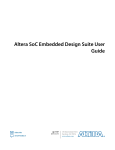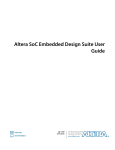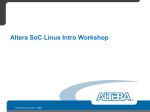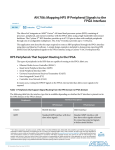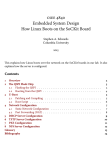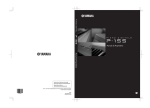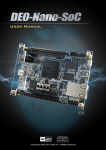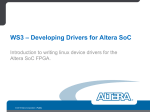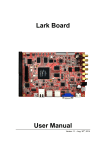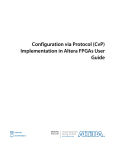Download Arria 10 SoC Boot User Guide
Transcript
Arria 10 SoC Boot User Guide 2015.10.30 UG-1171 Subscribe Send Feedback This document provides comprehensive information on boot flow, boot source devices and how to generate and debug a bootloader for the Arria® 10 SoC. The details provided in this SoC boot user guide are: • Typical boot flows supported by the Arria 10 SoC system • Available boot source devices and their configuration information • First and second boot stages (U-Boot or Unified Extensible Firmware Interface (UEFI)) • • • • Note: Although U-Boot is the primary example covered in this user guide, using UEFI as a secondstage non-general public license (non-GPL) boot loader source is also introduced. See "Appendix B: Building the UEFI Boot Loader" for more information. How to generate a boot loader and configure for a boot source device How to build a boot loader Debugging a boot loader Technical reference appendices for boot memories and the SoC development platform Related Information Appendix B: Building the UEFI Boot Loader on page 39 Boot Process Typical Boot Flow The booting of the HPS is a multi-stage process. Each stage is responsible for loading the next stage. The first stage is the boot ROM execution. The boot ROM code, located in the HPS, brings the processor out of reset, puts the processor into a known and stable state, finds the second-stage boot loader and passes control to the next stage. The boot ROM code is only aware of the second-stage boot loader and not aware of any potential subsequent software stages. During this time, the boot ROM also seamlessly handles any error conditions. The next stage is when control passes to the second-stage boot loader. The second-stage boot loader is located external to the HPS, either in external flash memory or within the FPGA. If the FPGA is used, the second stage boot loader can execute directly from the FPGA without the need to copy it to on-chip RAM. The second-stage boot loader locates and loads the next stage software and so on. Before control is passed to the second stage boot loader, it can be decrypted and/or authenticated if secure boot is enabled. © 2015 Altera Corporation. All rights reserved. ALTERA, ARRIA, CYCLONE, ENPIRION, MAX, MEGACORE, NIOS, QUARTUS and STRATIX words and logos are trademarks of Altera Corporation and registered in the U.S. Patent and Trademark Office and in other countries. All other words and logos identified as trademarks or service marks are the property of their respective holders as described at www.altera.com/common/legal.html. Altera warrants performance of its semiconductor products to current specifications in accordance with Altera's standard warranty, but reserves the right to make changes to any products and services at any time without notice. Altera assumes no responsibility or liability arising out of the application or use of any information, product, or service described herein except as expressly agreed to in writing by Altera. Altera customers are advised to obtain the latest version of device specifications before relying on any published information and before placing orders for products or services. www.altera.com 101 Innovation Drive, San Jose, CA 95134 ISO 9001:2008 Registered 2 UG-1171 2015.10.30 Bare Metal Boot Flow After a warm reset, the user can instruct the boot ROM to find an image in the on-chip RAM and execute directly from that. In this case, the image that resides in RAM is unauthenticated and clear text, although it may have been imported into on-chip RAM as authenticated code initially. The figure below illustrates the typical boot flow. However, there may be more or less software stages in the user software than shown and the roles of the software stages may vary. Figure 1: Typical Boot Flow An example of a typical boot flow second-stage boot loader is U-Boot. An example of a typical boot flow OS is Linux. User Software Reset Boot ROM Second-Stage Boot Loader Operating System Application Bare Metal Boot Flow The figure below shows a boot flow with a BareMetal application. Figure 2: BareMetal Boot Flow Reset Boot ROM Second-Stage Boot Loader BareMetal Custom Boot Loader You can also create your own custom boot loader if required. Figure 3: Custom Boot loader Flow Reset Altera Corporation Boot ROM Custom Boot Loader Application Arria 10 SoC Boot User Guide Send Feedback UG-1171 2015.10.30 Boot Stages 3 Boot Stages Reset Reset precedes the boot stages and is an important part of device initialization. There are two different reset types: cold reset and warm reset. The FPGA portion of the SoC can trigger a warm or cold reset on completion of configuration. The boot process begins when CPU0 in the MPU exits from the reset state. When CPU0 exits from reset, it starts executing code at the reset exception address where the boot ROM code is located. CPU1 remains in reset during this time and is brought out of reset by user software. With warm reset, some software registers are preserved and the boot process may skip some steps depending on software settings. In addition, on a warm reset, the second-stage boot loader has the ability to be executed from on-chip RAM. Related Information • Reset Manager For more information about software reset refer to the "Reset Manager" chapter in the Arria 10 Hard Processor System Technical Reference Manual. • Arria 10 Core Fabric and General Purpose I/Os Handbook For more information about FPGA configuration and reset First Stage: Boot ROM The boot ROM code is 128 KB in size and located in on-chip ROM at addresses 0xFFFC0000 to 0xFFFDFFFF. The function of the boot ROM code is to determine the boot source, initialize the HPS after a reset, and jump to the second-stage boot loader. If the second-stage boot loader image has already been loaded from the flash memory to on-chip RAM, the boot ROM jumps to on-chip RAM location. The boot ROM performs the following actions to initialize the HPS: • • • • Enables instruction cache, branch predictor, floating point unit, and NEON vector unit of CPU0 Sets up the level 4 (L4) watchdog 0 timer Configures dedicated pins based on Boot Select (BSEL) settings Initializes the flash controller to default settings When booting from flash memory, the boot ROM code uses the top 32 KB of the on-chip RAM as data workspace. This area is reserved for the boot ROM code after a reset until the boot ROM code passes software control to second-stage boot loader. The maximum second-stage boot loader size is 208 KB with authentication and 224 KB without. For a warm boot from RAM or a boot from FPGA, the boot ROM code does not reserve the top 32 KB of the on-chip RAM, and the user may place user data in this area without being overwritten by the boot ROM. Note: The boot ROM only initializes the portions within the 32 KB of on-chip RAM it uses. If ECC is required by the second-stage boot loader in on-chip RAM, then you should enable the security fuse that clears all RAMs on a cold reset. Refer to SoC Security chapter in the Arria 10 Hard Processor System Technical Reference Manual for more information on secure fuses. The boot process begins when CPU0 exits from the reset state. The boot ROM code only executes on CPU0. CPU1 is held in reset until it is released by user software. When CPU0 exits from reset, it starts executing code at the reset exception address. Arria 10 SoC Boot User Guide Send Feedback Altera Corporation 4 Boot ROM Flow UG-1171 2015.10.30 During boot ROM execution, the clock control fuse information is automatically sent to the Clock Manager, the memory control fuse information is automatically sent to the Reset Manager and all other fuse functions (authentication, encryption, private and public key source, hash functions) are stored in a memory-mapped location for boot code to read. In normal operation, the boot ROM is mapped at the reset exception address so code starts executing in the boot ROM. When CPU0 exits the boot ROM code and starts executing user software, boot ROM access is disabled. The user software executing on CPU0 must map the user software exception vectors to 0x0 (which was previously mapped to the boot ROM exception vectors) and release CPU1 from reset, if required. When CPU1 is released from reset, CPU1 executes the user software exception instead of the boot ROM. Related Information SoC Security For more information about security fuses, refer to the SoC Security chapter Arria 10 Hard Processor System Technical Reference Manual. Boot ROM Flow On a cold reset, the HPS boot process starts when CPU0 is released from reset (for example, on a power up) and executes code in the internal boot ROM at the reset exception address, 0x00000000. The boot ROM code brings the HPS out of reset and into a known state. After boot ROM code is exited, control passes to the next stage of the boot software, referred to as the second-stage boot loader. The second-stage boot loader can be customized and is typically stored external to the HPS in a nonvolatile flash-based memory or in on-chip RAM within the FPGA. The second-stage boot loader can then load an OS, BareMetal application or potentially a third-stage boot loader. This section describes the software flow from reset until the boot ROM code passes software control to the second-stage boot loader. The code starts, initializes the system and then depending on the type of boot requested, it may attempt to load the code into the on-chip RAM. If the load is successful, the second-stage boot loader code executes. If the boot ROM fails to find code or fails in three subsequent load attempts, it spins, waiting for a watchdog reset. Altera Corporation Arria 10 SoC Boot User Guide Send Feedback UG-1171 2015.10.30 Boot ROM Flow 5 Figure 4: Main Boot ROM Flow Reset Initialize System Boot Type Flash Boot FPGA Boot RAM Boot Reserved Boot High-Level Boot FPGA Boot RAM Boot Reserved Boot Code Valid? Error No Yes Jump to Code Spin Until Watchdog Reset Boot The boot ROM always executes on CPU0. CPU1 is always held in reset while the main boot ROM code is executing and is only released when required by system software. As part of determining the boot type, the boot ROM executes a low-level boot flow. The boot ROM code reads the security fuse to determine if the source of the second-stage boot is forced to be the FPGA. If a non-authenticated FPGA boot or a non-CRC on-chip RAM boot is requested or the boot is invalid, it is processed within the low-level boot flow. All other boot types are processed within the high-level boot flow. Arria 10 SoC Boot User Guide Send Feedback Altera Corporation 6 UG-1171 2015.10.30 Boot ROM Flow Figure 5: Low-Level Boot Flow Low-Level Boot Read Current Security Status in Security Manager Required to boot from FPGA? No Yes Must Authenticate? RAM Boot Allowed? No No Yes Yes Enable FPGA Access RAM Boot Valid? No Yes RAM Boot Read BSEL Pins FPGA Boot? Read BSEL Pins No FPGA Boot? Yes Boot Not Valid FPGA Boot Boot Valid FPGA Boot No Yes Boot Not Valid FPGA Boot Boot Not Valid Boot During the low-level portion of the boot ROM flow, the boot ROM reads the security fuses to determine if an FPGA-only boot is required. If so, then the boot ROM must also determine if the fuses indicate that authentication of the POF is needed. If no authentication is required, then a standard FPGA configuration occurs. If an FPGA-only boot is not required, then the boot ROM checks if an on-chip RAM boot is allowed. If it is, then the boot ROM checks to see if the code is valid. If the code is invalid, the boot ROM reads the BSEL pins to determine if it indicated an FPGA boot. If the secure fuses indicate that authentication is required for the boot image, then a high-level boot (executed in C code) must be performed. Altera Corporation Arria 10 SoC Boot User Guide Send Feedback UG-1171 2015.10.30 Boot ROM Flow 7 Figure 6: High-Level Boot Flow High-Level Boot Global Initialization Boot from FPGA & no Authenticate? Yes No Initialize Hardware RAM Boot Valid? No Yes RAM Boot Initialize DMA Load from flash Valid Image? No Yes No Error No Error No Error Error Continue Boot During the boot process, authentication and decryption can be performed on the boot image. Authentica‐ tion is independent of decryption; however, if both authentication and decryption are required, then authentication always occurs first. If an authenticated boot is required, then the boot ROM must have a root key to start the authentication process. This key can be implemented in the user fuses, in the FPGA logic elements or as part of the second-stage boot image header. The device configuration fuses determine the source of the key. During a cold boot from flash memory, the boot ROM code attempts to load the first second-stage boot loader image from flash memory to on-chip RAM and pass control to the second-stage boot loader. If this initial image is invalid, the boot ROM code indexes the romcode_initswlastld register and attempts to Arria 10 SoC Boot User Guide Send Feedback Altera Corporation 8 UG-1171 2015.10.30 Second Stage: Boot Loader (U-Boot) load the next stored image. The boot ROM will attempt three subsequent loads after the initial one. If there is still no valid image found after the subsequent loads, the boot ROM code checks the FPGA portion of the device for a fallback image. Note: During the boot process, the boot ROM enables all of the caches (L1 data and instruction caches and L2 cache). If the second-stage boot loader is not loaded from a boot flash device (SD/MMC, QSPI, NAND) properly, the caches may be left on when the boot ROM checks the FPGA portion the device for a fallback image. This situation can lead to issues of coherency when loading code, so caches must be flushed and disabled in the fallback image. If the warm RAM boot has failed or if a cold reset has occurred, then the boot ROM reads the BSEL value in the bootinfo register of the System Manager. If the FPGA is selected as the boot source, then the boot ROM code attempts to execute code at address 0xC0000000 across the HPS-to-FPGA bridge (offset 0x00000000 from bridge). No error conditions are generated if the FPGA does not initialize properly and the watchdog is not enabled for time-out. Instead, the boot ROM continues to wait until the FPGA is available. If the BSEL bits indicate a boot from external flash, then the boot ROM code attempts to load an image from a flash device into the on-chip RAM, verify and execute it. If the BSEL is invalid or the boot ROM code cannot find a valid image in the flash, then the boot ROM code checks if there is a fallback image in the FPGA. If there is, then the boot ROM executes the fallback image. If there is no fallback image then the boot ROM performs a post-mortem dump of information into the on-chip RAM and awaits a reset. Note: The acronyms BSEL and BOOTSEL are used interchangeably to define the boot select pins. The boot ROM code verifies the second-stage boot loader in several ways to ensure a corrupted image is not executed. The first test is of the image header, which identifies the magic number, version, block length, and CRC of the image that protects the block. If any of these are invalid, an error occurs. Second Stage: Boot Loader (U-Boot) Note: This section pertains to feature information for U-Boot. For information on UEFI boot loader features, refer to technical reference documentation for UEFI on Altera®'s wiki page. The function of the second-stage boot loader is user-defined. The Altera-provided second-stage boot loader is a combination of initialization, configuration and U-Boot code and contains features such as: • • • • • • • • • • • • • SD/MMC controller driver QSPI controller driver Ethernet driver plus protocol support Drivers for system-level IP, such as Clock Manager, System Manager, and FPGA Manager Cache memory drivers UART, timer and watchdog drivers FAT file system support Flat Image Tree (FIT) image processing U-Boot console support including basic essential debug commands Cryptographic library U-Boot device tree processing library System and memory firewall configuration Initialization code for the interface that loads the next stage of software If a secure boot is required, the second-stage boot loader can be used to increase the level of security and to authenticate and initiate decryption of the next boot image if necessary. Altera Corporation Arria 10 SoC Boot User Guide Send Feedback UG-1171 2015.10.30 Second-Stage Boot Flow 9 Configuring the SDRAM firewall allows the second-stage boot loader to load the next stage of the boot software into SDRAM. The maximum length for a second-stage boot loader to fit into on-chip RAM is 208 KB with authentication and 224 KB without authentication. A typical next software stage is loading the application OS software. The second-stage boot loader is allowed to load the next stage boot software from any device available to the HPS. Typical sources include the same flash device that contains the second stage boot loader, a different flash device, or a communication interface such as an EMAC. If the second-stage boot loader must be authenticated, it must store a public key. Below is a figure that depicts the second-stage boot loader image presented to the boot ROM, during a secure, authenticated boot. Figure 7: High-Level Diagram of Second-Stage Boot Loader Image Boot ROM Authentication Header Boot ROM Standard Header Second-Stage Boot Loader Binary Keys to Authenticate/Decrypt Next Stage Clock Configuration Pin Configuration Memory Configuration Second-Stage Boot Loader DTB Boot ROM Header CRC Related Information Altera Wiki Site Refer to this site for a description and technical reference material on UEFI. Second-Stage Boot Flow The second stage boot loader has the capability of supporting the following types of boot: Arria 10 SoC Boot User Guide Send Feedback Altera Corporation 10 UG-1171 2015.10.30 Typical Boot Flow (Non-Secure) • Non-secure clear text boot • Secure boot with: • Authentication only (also called verified boot) • Decryption only • Authentication and decryption Typical Boot Flow (Non-Secure) A non-secure second-stage boot process typically follows a flow as in the following figure. Figure 8: Typical Second-Stage Boot Loader Flow (Non-Secure) Second-Stage Boot Loader Entry Timer & UART Initialization Low-Level Initialization Assert Reset to Affected Peripherals/ Components during PLL Reconfiguration Clock Reconfiguration Configure Dedicated HPS I/O Configure Shared HPS I/O & Hard Memory Controller I/O Using Full or Early Release FPGA Configuration Flow SDRAM Interface Initialization (Include Calibration & PLL Configuration) Success? no yes Next Stage Boot Device Initialization Checking Boot Image’s Checksum (Optional) no FPGA Fabric and I/O Configured Thru FPGA? yes Configure Pin Multiplexing through the System Manager Reset Deassertion through the Reset Manager Checksum no Passed? yes Copy the Next Stage Boot Image from the Next Stage Boot Device to the SDRAM Write Magic Value to the Initial Software State Register System Interconnect Configuration Pass Control to Next Boot Stage Software in SDRAM Error Handler Low-level initialization steps include reconfiguring or disabling the L4 watchdog 0 timer, invalidating the instruction cache and branch predictor, remapping the on-chip RAM to the lowest memory region, and setting up the data area. Altera Corporation Arria 10 SoC Boot User Guide Send Feedback UG-1171 2015.10.30 Typical Boot Flow (Non-Secure) 11 Upon entering the second-stage boot loader, the L4 watchdog 0 timer is active. The second stage boot loader can disable, reconfigure, or leave the watchdog timer unchanged. Once enabled after reset, the watchdog timer cannot be disabled, only paused or reset. The instruction cache and branch predictor, which were previously enabled by the boot ROM code, must be invalidated. If the second-stage boot loader enables and uses the data cache, it must initialize all levels of the data cache before enabling. The second-stage boot loader must remap the exception vector table because the exception vectors are still pointing to the exception handler in the boot ROM when it starts executing. By setting the system interconnect remap bit 0 to one, the on-chip RAM mirrors to the lowest region of the memory map. After this remap, the exception vectors use the exception handlers in the boot loader image. The figure below shows the memory map before and after remap. Figure 9: Remapping the On-Chip RAM Boot ROM 0xFFFF_FFFF 0xFFE0_0000 ... 0xFFFD_FFFF On-Chip ROM 0xFFFC_0000 ... 0xBFFF_FFFF SDRAM 0x0010_0000 Unused 0x0002_0000 On-Chip ROM 0x0000_0000 Before On-Chip RAM Second-Stage Boot Loader 0xFFFF_FFFF 0xFFE0_0000 ... 0xFFFD_FFFF On-Chip ROM 0xFFFC_0000 ... 0xBFFF_FFFF SDRAM 0x0010_0000 Unused 0x0004_0000 On-Chip RAM 0x0000_0000 After On-Chip RAM The second-stage boot loader can reconfigure all HPS clocks. During clock reconfiguration, the boot loader asserts reset to the peripherals in the HPS affected by the clock changes. The I/O assignments for the HPS are configured as part of the IOCSR configuration in the second-stage boot loader. Effectively, a bitstream containing the I/O assignments is sent to the device as part of the initialization code in the second-stage boot loader. If the FPGA fabric and I/O have not yet been configured through the FPGA and the HPS needs to access SDRAM, you should program the HPS to use the full or early I/O release configuration method to configure the shared and hard memory controller I/O. Refer to "FPGA Configuration" section of the "Booting and Configuration" appendix in the Arria 10 Hard Processor System Technical Reference Manual for details on full and early I/O release configuration. The second-stage boot loader looks for a valid next-stage boot image in the next-stage boot device by checking the boot image validation data and checksum in the mirror image. Once validated, the secondstage boot loader copies the next-stage boot image (OS or application image) from the next-stage boot device to the SDRAM. Before software passes control to the next-stage boot software, the second-stage boot loader can write a valid value (0x49535756) to the romcode_initswstate register in the System Manager. This value indicates that there is a valid boot image in the on-chip RAM. The romcode_initiswlastld register holds the index of the last second-stage boot loader software image loaded by the Boot ROM from the Arria 10 SoC Boot User Guide Send Feedback Altera Corporation 12 UG-1171 2015.10.30 Secure Boot Flow boot device. When a warm reset occurs, the Boot ROM loads the image indicated by the romcode_initswlastld register if the BSEL value is the same as the last boot. Related Information Booting and Configuration Appendix For more information about flash configuration, refer to the Booting and Configuration Appendix of the Arria 10 Hard Processor System Technical Reference Manual. Secure Boot Flow The main purpose of secure boot is to pass the chain of trust to the subsequent boot software. During a secure boot, the second-stage boot loader may authenticate or decrypt the subsequent boot image, depending on the current state registers in the Security Manager. In addition, the second-stage boot loader must ensure that the subsequent boot image is executed from secure memory such as on-chip RAM. The second-stage boot loader fits into the chain of trust as such: Figure 10: Secure Boot Flow Secure World Normal World Boot ROM (on-chip ROM) Authenticate and/or Decrypt Chain of Trust Second-Stage Boot Loader (on-chip RAM) Authenticate and/or Decrypt Secure Micro-OS/ Application (on-chip RAM) Through Secure API Standard OS (SDRAM) The micro OS provides secure APIs to allow the application in the normal world OS to establish trusted services. During a verified boot, the second-stage boot loader only authenticates the OS image and other images required by the OS. A flow for a verified boot is shown below. Altera Corporation Arria 10 SoC Boot User Guide Send Feedback UG-1171 2015.10.30 Secure Boot Flow 13 Figure 11: Verified (Authenticated) Boot Flow Boot ROM (on-chip ROM) Second-Stage Boot Loader (on-chip RAM) Authenticate Only OS Image (SDRAM) Dotted lines represent files within OS Image zImage Device Tree Blob Filesystem Other For both the secure and verified boot, the subsequent boot image must be executed in on-chip RAM while the second-stage boot loader is still executing from on-chip RAM. In order to accommodate this require‐ ment, the authentication and decryption process might follow the following steps depicted in the next three diagrams, depending on the type of secure boot chosen. Arria 10 SoC Boot User Guide Send Feedback Altera Corporation 14 UG-1171 2015.10.30 Secure Boot Flow Figure 12: Second-Stage Boot Loader Authentication Process 5. The secure micro OS/application can consume all of the on-chip RAM On-chip RAM Second-Stage Boot Loader (loaded by boot ROM) 3. Boot Loader collapses to the end of on-chip RAM only keeping the copy and SHA functions 2. Authenticate the image and store the hash value SDRAM FIT Image which contains the secure micro OS/application 4. The second-stage boot loader copies the secure micro OS/application into on-chip RAM and verifies it by matching the SHA. If it matches, control is passed to micro OS/application 1. Load FIT image from flash into SDRAM Collapsed Second-Stage Boot Loader FIT Image which contains the secure micro OS/application Copy Function Altera Corporation SHA Function Arria 10 SoC Boot User Guide Send Feedback UG-1171 2015.10.30 Secure Boot Flow 15 Figure 13: Second-Stage Boot Loader Decryption Process 5. The secure micro OS/application can consume all of the on-chip RAM On-chip RAM SDRAM Second-Stage Boot Loader (loaded by boot ROM) FIT Image which contains the secure micro OS/application DMA and FPGA CSS Engine 2. Boot Loader collapses to the end of on-chip RAM only keeping the DMA function 3. Second-stage boot loader starts decryption process through CSS DMA 1. Load FIT image from flash into SDRAM Collapsed Second-Stage Boot Loader FIT Image which contains the secure micro OS/application DMA Function 4. The second-stage boot loader polls until decryption is completed. Then, control can be passed to secure micro OS/application Decryption is optional and is not required for secure boot. Upon entry into the second-stage boot loader, the CSS engine is enabled. The second-stage boot loader decrypts the subsequent boot image and disables the CSS engine upon exit. Arria 10 SoC Boot User Guide Send Feedback Altera Corporation 16 UG-1171 2015.10.30 Secure Boot Flow Figure 14: Second-Stage Boot Loader Authentication and Decryption Process 4. Second-stage boot loader copies secure micro OS/application into on-chip RAM and verifies by matching the SHA On-chip RAM SDRAM Second-Stage Boot Loader (loaded by boot ROM) 2. Authenticate the image and store the hash value FIT Image which contains the secure micro OS/application 7. The secure micro OS/application can consume all of the on-chip memory. DMA and FPGA CSS Engine 3. Boot Loader collapses to the end of on-chip RAM only keeping the copy, SHA, and DMA function 5. Second-stage boot loader starts decryption process through CSS DMA 1. Load FIT image from flash into SDRAM Collapsed Second-Stage Boot Loader DMA Function Copy Function FIT Image which contains the secure micro OS/application SHA Function 6. The second-stage boot loader polls until decryption is completed. Then, control can be passed to secure micro OS/application Altera Corporation Arria 10 SoC Boot User Guide Send Feedback UG-1171 2015.10.30 Boot Devices 17 Boot Devices Boot Select The boot select (BSEL) pins offer multiple methods to obtain the second-stage boot image. On a cold reset, the boot source is determined by a combination of secure boot fuses and BSEL pins. These fuse values and BSEL pin values are sent to the Security Manager module of the HPS when the cold reset occurs. When the HPS is released from reset, the boot ROM reads the bootinfo register of the System Manager to determine the source of the boot. Note: If the fpga_boot_f fuse is blown, the BSEL pins are bypassed and the HPS can only boot from the FPGA. Additionally, the clock select (CSEL) fuse values are ignored and clock configuration is controlled through the FPGA. This configuration allows the HPS to boot from encrypted user code in the FPGA. If the boot source is the FPGA, the boot ROM code does not configure any of the boot-specific HPS I/Os for booting from flash memory. If the fpga_boot_f fuse is not blown, then the boot source is determined according to the BSEL pins. If the BSEL pins are used for determining the boot source, then the following table shows the flash devices assigned to each encoding. Note: If a boot from FPGA is required (BSEL[2:0]=0x1), then you must ensure that the HPS is not released from reset until after the FPGA has been fully programmed. Otherwise, the bootinfo register to determine the boot source might be read incorrectly by the boot ROM. FPGA readiness is indicated by handshake signals, f2h_boot_from_fpga_ready and f2h_boot_from_fpga_on_failure, from the FPGA to the HPS. The f2h_boot_from_fpga_ready signal must be pulled up to indicate readiness. Refer to the "Instantiating the HPS Component" chapter for more information about FPGA boot handshake signals. Note: The acronyms BSEL and BOOTSEL are used interchangeably to define the boot select pins. Table 1: BSEL Values for Boot Source Selection BSEL[2:0] Value Flash Device 0x0 Reserved 0x1 FPGA (HPS-to-FPGA bridge) 0x2 1.8 V NAND flash memory 0x3 3.0 V NAND flash memory 0x4 1.8 V SD/MMC flash memory with external transceiver 0x5 3.0 V SD/MMC flash memory with internal transceiver 0x6 1.8 V quad SPI flash memory 0x7 3.0 V quad SPI flash memory Note: If the BSEL value is set to 0x4 or 0x5, an external translation transceiver may be required to supply level-shifting and isolation if the SD cards interfacing to the SD/MMC controller must operate at a different voltage than the controller interface. Please refer to the SD/MMC Controller chapter for more information. The typical boot flow is for the boot ROM code to find the second-stage boot loader image on a flash device, load that into on-chip RAM and execute it. After a warm reset, the boot ROM code can be instructed to find the image in RAM and execute that. Arria 10 SoC Boot User Guide Send Feedback Altera Corporation 18 UG-1171 2015.10.30 Flash Memory Devices for Booting The HPS flash sources can store various file types, such as: • • • • FPGA programming files Second-stage boot loader binary file (up to four copies) Operating system binary files Application file system The second-stage boot loader image in flash can be authenticated and decrypted by the HPS. A boot directly from the HPS on-chip RAM is always unauthenticated and in clear text, although it may have an optional CRC if required. When the BSEL value is 0x1, the FPGA is selected as the boot source for that boot. This selection is not permanent as it is when the fpga_boot_f fuse is enabled. In both cases, the CSEL fuses are also ignored and the HPS must be held in reset until the FPGA is powered on and programmed to prevent the boot ROM from misinterpreting the boot source. If an HPS flash interface has been selected to load the boot image, then the boot ROM enables and configures that interface before loading the boot image into on-chip RAM, verifying it and passing software control to the second-stage boot loader. If the FPGA fabric is the boot source, the boot ROM code waits until the FPGA portion of the device is in user mode, and is ready to execute code and then passes software control to the second-stage boot loader in the FPGA RAM. Flash Memory Devices for Booting The memory controllers and devices that contain the boot loader image have configuration requirements for proper boot from flash. On all flash devices, there is an area of memory, called the boot area that contains up to four second-stage boot loader images. For the QSPI and SD/MMC devices, the boot area is 1 MB in size. For NAND devices the boot area is four device blocks in size and may be larger than 1 MB if the NAND erase block is larger than 256 KB. The SD/MMC, Quad SPI and NAND flash devices all support raw and MBR (partition) mode. In raw mode, the boot image is located at the start of the flash memory device, at offset 0x0. In MBR mode: • The boot image is read from a custom partition (0xA2) • The first image is located at the beginning of the partition, at offset 0x0 • Start address = partition start address Quad SPI Flash Devices The figure below shows the quad SPI flash image layout. The second-stage boot loader image is always located at offsets that are multiples of 256 KB. Figure 15: Quad SPI Flash Image Layout Second-Stage Boot Loader Image 3 Second-Stage Boot Loader Image 2 0x0 Altera Corporation Second-Stage Boot Loader Image 1 Second-Stage Boot Loader Image 0 Multiple of 256 KB Arria 10 SoC Boot User Guide Send Feedback UG-1171 2015.10.30 SD/MMC Flash Devices 19 The boot ROM code configures the quad SPI controller to default settings for the supported SPI or quad SPI flash memory. Related Information Flash Memory Devices For more information on default settings and CSEL pin settings for flash memory devices, refer to the Booting and Configuration Appendix of the Arria 10 Hard Processor System Technical Reference Manual. SD/MMC Flash Devices The following figure shows an SD/MMC flash image layout example for boot. The master boot record (MBR) is located in the first 512 bytes of the memory. The MBR contains information about the partitions (address and size of partition). The second-stage boot loader image is stored in partition A2. Partition A2 is a custom raw partition with no file system. Figure 16: SD/MMC Flash Image Layout Second-Stage Boot Loader Image 3 Second-Stage Boot Loader Image 2 Second-Stage Boot Loader Image 1 0x0 Partition Type: A2 Partition Size: 256 KB x 4 Second-Stage Boot Loader Image 0 ... MBR Partition Size: 512 Bytes Master Boot Record (MBR) The SD/MMC controller supports two booting modes: • MBR (partition) mode • The boot image is read from a custom partition (0xA2) • The first image is located at the beginning of the partition, at offset 0x0 • Start address = partition start address • Raw mode • If the MBR signature is not found, SD/MMC driver assumes it is in raw mode • The boot image data is read directly from sectors in the user area and is located at the first sector of the SD/MMC • The first image is located at the start of the memory card, at offset 0x0 • Start address = 0x0 The MBR contains the partition table, which is always located in the first sector (LBA0) with a memory size of 512 bytes. The MBR consists of executable code, four partition entries, and the MBR signature. A MBR can be created by specific tools like the FDISK program. Arria 10 SoC Boot User Guide Send Feedback Altera Corporation 20 UG-1171 2015.10.30 SD/MMC Flash Devices Table 2: MBR Structure Offset Size (In Bytes) Description 0x000 446 Code area 0x1BE 16 Partition entry for partition 1 0x1CE 16 Partition entry for partition 2 0x1DE 16 Partition entry for partition 3 0x1EE 16 Partition entry for partition 4 0x1FE 2 MBR signature: 0xAA55 The standard MBR structure contains a partition with four 16-byte entries. Thus, memory cards using this standard table cannot have more than four primary partitions or up to three primary partitions and one extended partition. Each partition type is defined by the partition entry. The boot images are stored in a primary partition with custom partition type (0xA2). The SD/MMC flash driver does not support a file system, so the boot images are located in partition A2 at fixed locations. Table 3: Partition Entry Offset Size (In Bytes) Description 0x0 1 Boot indicator. 0x80 indicates that it is bootable. 0x1 3 Starting CHS value 0x4 1 Partition type 0x5 3 Ending CHS value 0x8 4 LBA of first section in partition 0xB 4 Number of sectors in partition The boot ROM code configures the SD/MMC controller to default settings for the supported SD/MMC flash memory. Related Information Flash Memory Devices For more information on default settings and CSEL pin settings for flash memory devices, refer to the Booting and Configuration Appendix of the Arria 10 Hard Processor System Technical Reference Manual. Altera Corporation Arria 10 SoC Boot User Guide Send Feedback UG-1171 2015.10.30 NAND Flash Devices 21 NAND Flash Devices The NAND subsystem reserves at least the first 1 MB on the NAND device. If the NAND flash device has blocks greater than 256 KB, then the NAND subsystem reserves the first four blocks on the device. For a NAND device with less than 256 KB block size, the second-stage boot loader image must be placed in multiple blocks. The NAND subsystem expects to find up to four second-stage boot loader images on the NAND device. You may have less than four images if required. The second-stage boot loader image should always be at the start of a physical page. Because a block is the smallest area used for erase operation, any update to a particular image does not affect other images. Figure 17: NAND Flash Image Layout for 256 KB Memory Blocks 0xFFFFF Second-Stage Boot Loader Image 3 0xC0000 Second-Stage Boot Loader Image 2 0x80000 Second-Stage Boot Loader Image 1 Each block available for the boot loader image is 256 KB 0x40000 Second-Stage Boot Loader Image 0 0x00000 Related Information Flash Memory Devices For more information on default settings and CSEL pin settings for flash memory devices, refer to the Booting and Configuration Appendix of the Arria 10 Hard Processor System Technical Reference Manual. Booting From FPGA In the figure below, the FPGA is configured first through one of its non-HPS configuration sources. The CSS block configures the FPGA fabric as well as the FPGA I/O, shared I/O and hard memory controller I/O. The HPS executes the second-stage boot loader from the FPGA. In this situation, the HPS should not be released from reset until the FPGA is powered on and programmed. Once the FPGA is in user mode and the HPS has been released from reset, the boot ROM code begins executing. The HPS boot ROM code executes the second-stage boot loader from the FPGA fabric over the HPS-to-FPGA bridge. Arria 10 SoC Boot User Guide Send Feedback Altera Corporation 22 UG-1171 2015.10.30 Booting From FPGA Figure 18: Boot From FPGA Flow Shared I/O CSS Active Serial/ Active Serial x4 Boot & Configuration Sources Passive Serial Passive Parallel MPU FPGA Fabric Boot ROM JTAG FPGA I/O HPS-to-FPGA Bridge FPGA HPS HPS Dedicated I/O PCIe Hard Memory Controller I/O Altera Corporation Arria 10 SoC Boot User Guide Send Feedback UG-1171 2015.10.30 Second-Stage Boot Loader Support Package Generator Tool 23 Second-Stage Boot Loader Support Package Generator Tool The SoC Embedded Design Suite (SoC EDS) includes the second-stage boot loader support package (BSP) generator tool that allows you to generate a boot loader for your FPGA design. The boot generation flow and BSP Editor tool are described in the following sections. Boot Loader Generation and Flow Generating a boot loader involves several steps to produce a final bootable image. Each step is dependent on the previous one. Either the associated Altera Complete Design Suite (ACDS) or SoC EDS tool is used to generate information required for the following dependent steps. See the table below for a list of steps and associated tools: Table 4: Boot Loader Generation Stages and Tools Steps Required Tool Step 1: Compiling the FPGA Design Quartus® Prime Step 2: Identifying the hardware hard processor system (HPS) hand-off files Quartus Prime Step 3: Generating and building a boot loader source SoC EDS tool chain and BSP Editor The following figure depicts the complete boot loader generation flow using U-Boot. Note: A similar flow is available for a UEFI boot loader. Refer to the "Appendix B: Building a UEFI Boot Loader" section. Figure 19: Arria 10 Boot Loader Generation Flow User Options U-Boot Device Tree Handoff Folder (XML Files) make U-Boot Binary & U-Boot Device Tree Image BSP Editor U-Boot Makefile Hardware Design Quartus II SD Card U-Boot Source Core RBF SOF Quartus CPF Peripheral RBF Legend Part of SoC EDS Part of ACDS Arria 10 SoC Boot User Guide Send Feedback Altera Corporation 24 UG-1171 2015.10.30 Step 1: Compiling the FPGA Design Related Information • Appendix B: Building the UEFI Boot Loader on page 39 • Altera SoC Embedded Design Suite User Guide For more information about the BSP tools refer to the Altera SoC Embedded Design Suite User Guide. Step 1: Compiling the FPGA Design For details on Step 1: Compiling the FPGA Design refer to the GSRD User Manual. Related Information GSRD User Manual Step 2: Hardware Hand-off Files Prior to generating the boot loader, the HPS hand-off files are needed. The hand-off files are created during "Step 1: Compiling the FPGA Design" and are saved in the hps_isw_handoff folder. The HPS hand-off files contain the FPGA hardware design information (as XML files) and are used to generate the required boot loader device tree for proper FPGA hardware initialization and run-time access. Related Information • Clock Select For more information, refer to the "Clock Selects" section in the Booting and Configuration Appendix of the Arria 10 Hard Processor System Technical Reference Manual. • I/O Configuration For more information, refer to the "I/O Configuration" section in the Booting and Configuration Appendix of the Arria 10 Hard Processor System Technical Reference Manual. Step 3: Generating the Boot Loader Source This step in the boot generation flow is discussed as an example in section "Generating a Boot Loader with a QSPI Boot Device." Related Information Generating a Boot Loader with a QSPI Boot Device on page 28 Boot Loader Generator Tool: BSP Editor The BSP Editor tool provides you with guided options to configure and generate a boot loader image. The BSP Editor tool is also used for editing an existing generated boot loader by modifying the BSP configura‐ tion settings that are saved in the settings.bsp file. The BSP Editor main interface is shown below. Altera Corporation Arria 10 SoC Boot User Guide Send Feedback UG-1171 2015.10.30 Boot Loader Generator Tool: BSP Editor 25 Figure 20: BSP Editor The tool provides the configuration options that include selecting: • Associated HPS hand-off files • Target OS (both U-Boot or UEFI boot use the U-Boot OS selection) Note: Although U-Boot is the primary example covered in this user guide, using UEFI as a secondstage boot loader source is also introduced. See "Appendix B: Building the UEFI Boot Loader" for more information. • Locations for boot loader • Source and configuration settings (BSP settings). These options are present whether creating a new or editing an existing boot loader configuration. The figure below shows the settings for generating a new boot loader. Arria 10 SoC Boot User Guide Send Feedback Altera Corporation 26 UG-1171 2015.10.30 Boot Loader Generator Tool: BSP Editor Figure 21: BSP Settings for New Boot Loader Generation When creating a new or editing an existing BSP, the BSP-Editor tool provides the following selections: • • • • • • • Preloader settings directory: Location of the HW HPS hand-off files Operating system: Target platform boot loader (U-Boot or UEFI) Version: Target platform boot loader version (use default or recommended) BSP target directory: Location of generated BSP BSP Settings File name: Location of BSP settings file Enable Additional Tcl Script: Includes a Tcl script for additional custom settings Additional Tcl script: Location of additional Tcl script After the initial configuration settings are entered, you can edit the boot loader source device selection, the platform model selection, and the FPGA configuration files and select whether to automatically build the boot loader after generation. The BSP Editor window below shows an example configuration. Altera Corporation Arria 10 SoC Boot User Guide Send Feedback UG-1171 2015.10.30 Boot Loader Generator Tool: BSP Editor 27 Figure 22: Example Configuration The continued configuration selections in this window are: • • • • • boot_device: Selects the target boot device for the generated boot loader model: Target SoC device platform peripheral_rbf_filename: Peripheral FPGA configuration file core_rbf_filename: Core FPGA configuration file disable_uboot_build: When selected, the BSP will not be built (default) Note: The boot_device configuration is selected in the HPS Megawizard and should not be changed in the boot_device pulldown of this window. Arria 10 SoC Boot User Guide Send Feedback Altera Corporation 28 UG-1171 2015.10.30 Generating a Boot Loader with a QSPI Boot Device Generating a Boot Loader with a QSPI Boot Device This section describes detailed steps to generate a bootable image. Prerequisites For generating a boot loader with QSPI boot flash, the following tools are required: • • • • • • Arria 10 SoC development kit QSPI boot flash daughter card U-boot and Linux source code compatible with the Arria 10 SoC Version of Quartus Prime that supports Arria 10 SoC booting from QSPI FPGA design with proper pin configuration for QSPI boot ARM® DS-5 development studio version 5.20.2 or later or GNU debug package Boot Loader Generation Example Using QSPI 1. Launch the SoC EDS embedded command shell: $ ~/altera/15.0/embedded/embedded_command_shell.sh 2. Launch the BSP Editor tool from the SoC EDS embedded command shell: $ bsp-editor 3. Create a new HPS BSP in the window by selecting File > New HPS BPS and configure the following: a. Specify a hardware HPS hand-off folder in the Preloader settings directory. b. Specify the boot loader sources folder in the BSP target directory text box. c. Specify the boot loader configuration and settings file location in the BSP Settings File name text box. Altera Corporation Arria 10 SoC Boot User Guide Send Feedback UG-1171 2015.10.30 Boot Loader Generation Example Using QSPI 29 Figure 23: Selecting New BSP Editor Window Arria 10 SoC Boot User Guide Send Feedback Altera Corporation 30 UG-1171 2015.10.30 Boot Loader Generation Example Using QSPI Figure 24: Configuring New BSP Settings 4. Click OK after fields are set and specify the source boot_device (QSPI) in the main menu tab. Note: The .rbf files only apply when booting from SD/MMC. For QSPI configuration, these text boxes do not need to be edited, but instead a single .rbf file must be created through a conversion script. Altera Corporation Arria 10 SoC Boot User Guide Send Feedback UG-1171 2015.10.30 Boot Loader Generation Example Using QSPI 31 Figure 25: Selecting Boot from QSPI Device in BSP Editor Window 5. Select Generate and the boot loader and U-Boot source files are created in the folder you specified as the BSP target directory. 6. Move to the U-Boot boot loader source folder and build the image. $ cd ~/a10_soc_devkit_ghrd/software/arria10_uboot_bsp $ make The following items are generated in the ~/a10_soc_devkit_ghrd/software/arria10_uboot_bsp/ folder: Table 5: Boot Loader Executable Images File Description u-boot_w_dtb.bin U-boot executable with device tree binary uboot_w_dtb-mkpimage.bin U-boot executable with mkpimage header Note: If you choose to use UEFI as a second-stage boot loader source, refer to the "Appendix B: Building the UEFI Boot Loader" section at this point. 7. When booting from QSPI, a single .rbf file is needed that contains both the FPGA core fabric configu‐ ration and the I/O ring settings. This requirement is different from SD/MMC booting where Arria 10 SoC Boot User Guide Send Feedback Altera Corporation 32 UG-1171 2015.10.30 Boot Loader Generation Example Using QSPI separate .rbf files are needed. The conversion can be accomplished for the embedded command shell, by typing the following: $ ~/altera/15.0/embedded/embedded_command_shell.sh $ cd ~/a10_soc_devkit_ghrd/ $ quartus_cpf -c -o bitstream_compression=on output_files/ghrd_10as066n2.sof output_files/ghrd_10as066n2.rbf This creates a combined FPGA fabric and I/O ring configuration file named ghrd_10as066n2.rbf in the ~/a10_soc_devkit_ghrd/output_files/ folder. 8. Before the U-Boot software can load the FPGA image file, it must have information about the image, such as length or CRC. The information is passed to the U-boot tool by running the mkimage tool from the embedded command shell: $ ~/altera/15.0/embedded/embedded_command_shell.sh $ cd ~/a10_soc_devkit_ghrd/ $ mkimage -A arm -T firmware -C none -O u-boot -a 0 -e 0 -n "A10 GHRD RBF" -d output_files/ghrd_10as066n2.rbf output_files/ghrd_10as066n2.rbf.bin This creates the a combined FPGA fabric and I/O ring configuration file wrapped in a U-Boot header. The generated file name is ghrd_10as066n2.rbf.bin file and is found in the ~/a10_soc_devkit_ghrd/output_ files/ghrd_10as066n2.rbf.bin folder. 9. The HPS Flash Programmer is used to write the U-Boot and device tree image and the .rbf file to the QSPI boot card. The input files to the HPS Flash Programmer must always have a .bin extension. If your files do not, they must be renamed. Write the combined U-Boot and device tree image to the QSPI by typing the following commands: $ ~/altera/15.0/embedded/embedded_command_shell.sh $ quartus_hps -c 1 -o PV ~/a10_soc_devkit_ghrd/software/arria10_uboot_bsp/ uboot_w_dtb-mkpimage.bin This command takes a couple of minutes to complete. 10.Write the .rbf file to the QSPI device, by typing the following commands: $ ~/altera/15.0/embedded/embedded_command_shell.sh $ quartus_hps -c 1 -o PV -a 0x720000 ~/a10_soc_devkit_ghrd/output_files/ ghrd_10as066n2.rbf.bin This command may take up to 45 minutes to complete. Altera recommends initially programming with the HPS Flash Programmer; however, for further updates, use the U-Boot console for faster performance of these steps. 11.Power the board. It should boot from the QSPI and stop at the U-boot console. Related Information • Quad SPI Flash Devices on page 18 Refer to this section for more information about Quad SPI Flash. • Appendix B: Building the UEFI Boot Loader on page 39 • Altera SoC Embedded Design Suite User Guide For more information about required software development tasks • RocketBoards Website Altera Corporation Arria 10 SoC Boot User Guide Send Feedback UG-1171 2015.10.30 Boot and FPGA Configuration 33 Boot and FPGA Configuration During the boot process, the FPGA can be configured using the second-stage boot loader. Alternatively, you can configure the FPGA through a non-HPS source such as a external flash device or by using the Quartus Prime tool. Related Information Booting and Configuration Appendix For more information about flash configuration, refer to the Booting and Configuration Appendix of the Arria 10 Hard Processor System Technical Reference Manual. Boot Debugging This section presents some techniques that can help with the debug of the booting process. Considerations are included for Boot ROM and boot loader. The rest of the boot flow is generic and can be debugged with general purpose techniques. Cold Boot Debug A cold boot is initiated by power cycling the board or by issuing a cold reset when applicable. Common signs of power-on boot issues are: • No signs of hardware activity (for example, no blinking LEDs). • Inactive display console (for example, no UART output or no HPS software execution) • Interrupted and frozen boot software execution Although executing the boot ROM is the first boot stage during power up or cold boot, there are other hardware dependencies that must be examined to verify a successful boot. Additionally, test measurement equipment, such as a logic analyzer and oscilloscope can be used to check signal states and levels and monitor the activity during the boot process. Verifying that the hardware platform is stable and dependencies of the boot software are within specification ensures that the boot ROM and boot loader are able to load and run. Below is a sample of dependencies to check when verifying a successful boot: • Check the board power source. Ensure that it is within specification and there is not excessive noise present. • Verify the power sequencing is in order and all levels are within specification for each stage. • Input clock must be verified for amplitude, frequency, noise and jitter. • Verify all reset signal are sequenced to the design specification and levels. Warm Boot Debug Some possible causes of a warm debug issue: • The application software enabled the warm boot incorrectly. • The application software modified the warm reset options in a way that is not consistent with the usage scenario. • The boot source used is not reset during a warm reset. Arria 10 SoC Boot User Guide Send Feedback Altera Corporation 34 UG-1171 2015.10.30 Using the Boot ROM and Boot Loader Debug Registers Using the Boot ROM and Boot Loader Debug Registers If the HPS executes the boot loader state, registers maintained by the boot ROM and boot loader have been updated through the boot process. These registers provide useful status and information and can be examined to help determine a possible cause of boot failure. The registers are available in the sysmgr.romcodegrp of the System Manager. Below are the registers and descriptions: • initswstate – The boot loader writes the magic value 0x49535756 to the register prior to jumping to the next valid boot stage. If this value is absent, it indicates the boot loader failed to execute the following boot stage. • initswlastld – Contains the index of the last boot loader software image loaded from the boot source device. Up to four boot loader images can be loaded. • bootromswstate – Contains the boot ROM state information: • Bit[0]: When this bit is set, it indicates there was a failure to load all boot images. • Bit[1]: When this bit is set, it indicates the boot loader started or was running (and may have subsequently failed) • Bits[11:8] This field indicates the boot flash device: • 0x0= NAND • 0x1= SD/MMC • 0x2= QSPI Boot Flash Device Issues If the HPS is executing software, but the boot ROM fails to load the boot loader image, possible causes could be that: • The boot loader images are corrupted in the boot device flash. • The boot loader images are valid but the boot flash device communication has errors. • The boot loader image loads successfully, but runtime execution fails due to a software bug. To help reduce flash device communication issues, set CSEL=0x0. This prevents the boot ROM from reprogramming the PLLs and forces the boot ROM to use the lowest communication speed with the device. Flash memory signals should be monitored, if available, with proper test and measurement equipment (logic analyzer or oscilloscope) to: • • • • Determine if the duration of the communication is not within specification Observe if the boot ROM communication is prematurely aborted Verify signal integrity, such as voltage levels and rise and fall times Capture (with a logic analyzer) HPS and flash device communication If problems still persist and a debugger connection is available, then the contents of the upper 4KB of onchip RAM can be dumped from the debugger for Altera to analyze. Related Information Altera Support Center To log into the support center page and access the mySupport service request system. Altera Corporation Arria 10 SoC Boot User Guide Send Feedback UG-1171 2015.10.30 HPS Boot Loader Debugging 35 HPS Boot Loader Debugging In cases where a debugger connection is not available, and the HPS is booting from flash, flash device signals should be monitored. Please refer to the "Boot Flash Device Issues" section. Using a debugger is most effective for debugging the boot loader execution because it can access the source code. The following general-purpose debugging techniques can be used: • On systems with a JTAG connection, use a debugger to step through boot loader's execution. • Alternatively, the boot loader code can be modified to provide more useful debug information through hardware resources such as LEDs, UART, or writing to an unused memory location. Related Information • Boot Flash Device Issues on page 34 • ARM Infocenter For more information about debugging the bootloader using the ARM DS-5 Arria 10 SoC Boot User Guide Send Feedback Altera Corporation 36 UG-1171 2015.10.30 Appendix A: Generating a Boot Loader Using SD/MMC Boot Device Appendix A: Generating a Boot Loader Using SD/MMC Boot Device Boot Loader Example 1. Launch the SoC EDS embedded command shell: $ ~/altera/15.0/embedded/embedded_command_shell.sh 2. Launch the BSP Editor tool from the SoC EDS embedded command shell: $ bsp-editor 3. Create a new HPS BSP in the window by selecting File > New HPS BPS and configure the following: a. Specify a hardware HPS hand-off folder in the Preloader settings directory. b. Specify the boot loader sources folder in the BSP target directory text box. c. Specify the boot loader configuration and settings file location in the BSP Settings File name text box. Figure 26: Selecting New BSP Editor Window Altera Corporation Arria 10 SoC Boot User Guide Send Feedback UG-1171 2015.10.30 Boot Loader Example 37 Figure 27: Configuring New BSP Settings 4. Click OK after fields are set and specify the source boot_device (SD/MMC) in the main menu tab. Arria 10 SoC Boot User Guide Send Feedback Altera Corporation 38 UG-1171 2015.10.30 Boot Loader Example Figure 28: Selecting Boot from SD/MMC Device in BSP Editor Window 5. Select Generate and the boot loader and U-Boot source files are created in the folder you specified as the BSP target directory. 6. Change to the U-Boot boot loader source directory and build the image: $ cd ~/a10_soc_devkit_ghrd/software/arria10_uboot_bsp $ make The following items are generated in the ~/a10_soc_devkit_ghrd/software/arria10_uboot_bsp/ folder: Table 6: Boot Loader Executable Images File Description u-boot_w_dtb.bin U-boot executable with device tree binary uboot_w_dtb-mkpimage.bin U-boot executable with mkpimage header Note: If you choose to use UEFI as a second-stage boot loader source, refer to the "Appendix B: Building the UEFI Boot Loader" section at this point. 7. Prepare the boot loader image, U-Boot device tree and FPGA design on the boot device. For more information, please refer to the Altera SoC Embedded Design Suite User Guide or the Rocketboards website. Altera Corporation Arria 10 SoC Boot User Guide Send Feedback UG-1171 2015.10.30 Appendix B: Building the UEFI Boot Loader 39 Related Information • SD/MMC Flash Devices on page 19 Refer to "SD/MMC Flash Devices" section for more information. • Appendix B: Building the UEFI Boot Loader on page 39 Appendix B: Building the UEFI Boot Loader To build a Unified Extensible Firmware Interface (UEFI) boot loader you must obtain the UEFI source code and compile the UEFI source with the supported toolchain. Prerequisites To build a UEFI boot loader, install packages are required. Depending on your Linux distribution, the command to install the packages is different. If you are using a Ubuntu distribution, type: $ sudo apt-get install uuid-dev build-essential If you are using a Fedora distribution, type: $ sudo yum install uuid-devel libuuid-devel Note: For building UEFI, the Python package is required. If your host does not have Python installed, you can obtain it from the SoC EDS installation path, by typing: $ export PATH=$SocEDS_DEST_ROOT/host_tools/python/bin:$PATH If an error is reported by hashlib.py, install libssl.so.1.0.0 by typing: $ export LD_LIBRARY_PATH=$SOCEDS_DEST_ROOT/host_tools/python/lib/:$LD_LIBRARY_PATH/ sbin/ldconfig Supported Compiler Toolchains The supported UEFI compiler toolchains are: • Linaro: this toolchain is available within the SoC EDS installation package • arm-linux-gnueabihf-gcc (crosstool-NG linaro-1.13.1-4.8-2014.04 – Linaro GCC 4.8-2014.04) 4.8.3 20140401 (prerelease) • ARM (armcc, armlink): this toolchain is available within the SoC EDS DS-5 installation package Arria 10 SoC Boot User Guide Send Feedback Altera Corporation 40 UG-1171 2015.10.30 Obtaining the UEFI Source Code Obtaining the UEFI Source Code The UEFI source code is located in GitHub. The following steps show you how to get the UEFI source code. 1. Open a terminal. 2. Create a new directory path to check out the UEFI source code from GitHub. $ mkdir /data/<username>/pggit 3. Change to this UEFI working directory and clone the UEFI source from the git trees. $ cd /data/<username>/pggit $ git clone https://github.com/altera-opensource/uefi-socfpga.git 4. When completed, change to the uefi-socfpga folder and perform a git checkout. $ cd uefi-socfpga $ git checkout –t –b socfpga-linaro-edk2-2014.10-a3 origin/socfpga-linaroedk2-2014.10-a3 $ git reset tags/rel_socfpga_arria10_beta Compiling the UEFI Source Code with the Linaro Tool Chain This section explains how to compile the UEFI source code with the Linaro tool chain. 1. Open a terminal window and enter the following command: $ cd /data/<username>/pggit/uefi-socfpga $ make clean Note: make clean deletes your entire /data/<username>/pggit/uefi-socfpga/Build/ folder and also cleans the BaseTools. 2. Compile the UEFI boot loader for Arria 10 device using the following command. The build process takes less than three minutes. $ make Note: Typing make is equivalent to make DEVICE=a10 COMPILER=gcc After the build has completed, a Build Done message displays. Compiling the UEFI Source Code with the ARM Tool Chain This section explains how to compile the UEFI source code with the ARM tool chain. 1. Open a terminal window and enter the following command: $ cd /data/<username>/pggit/uefi-socfpga $ make clean Altera Corporation Arria 10 SoC Boot User Guide Send Feedback UG-1171 2015.10.30 UEFI Generated Files 41 Note: make clean deletes your entire /data/<username>/pggit/uefi-socfpga/Build/ folder and also cleans the BaseTools. 2. Compile the UEFI boot loader. $ make DEVICE=a10 COMPILER=gcc HANDOFF_DTB=a10_soc_devkit_ghrd_qspi/software/ bootloader/devicetree.dtb UEFI Generated Files Compiling the UEFI source code creates the following files in the /data/<username>/pggit/uefi-socfpga/Build/ folder: Table 7: UEFI Generated Files File ~ /uefi-socfpga/Build/PEI.256 (256KB) Description This file is generated from the mkpimage tool by adding a header to the original file located at ~/uefisocfpga/ Build/Arria10SoCPkg/ RELEASE_GCC48/FV/ALTERA_HPS_OCRAM_EFI_ PART1.fd. The file loads directly into the on- chip RAM using DS-5 because it is only 256 KB in size. This file generates the PEI.ROM file. ~ /uefi-socfpga/Build/PEI.ROM (1MB = 256KB X 4) This file is programmed onto the flash daughter card. The size of this file is four times bigger because the the boot ROM can support up to four backup images. For example, if the first image (256KB) is corrupted, the boot ROM loads the second image and so on. ~ /uefi-socfpga/Build/load_uefi_fw.ds This is the DS-5 script template. It is imported to the DS-5 tool and loads the UEFI firmware for debug and development purposes. This script loads the debug symbols for the user. Currently, it only supports the GCC compiler. ARMCC is not supported. ~ /uefi-socfpga/Build/DXE.ROM This file is currently not in use. Reserved for future use. Arria 10 SoC Boot User Guide Send Feedback Altera Corporation 42 UG-1171 2015.10.30 Revision History for Arria 10 SoC Boot User Guide Revision History for Arria 10 SoC Boot User Guide Date Version Changes October 2015 2015.10.30 • Added "Appendix B: Building the UEFI Boot Loader" section and subsections • Removed "Advanced Boot Topics" section June 2015 2015.06.12 • Removed "Alternate OS Boot Flow" section • Updated "Typical Second-Stage Loader Flow (Non-Secure)" figure in "Typical Boot Flow (Non-Secure)" section • Updated "Selecting New BSP Editor Window" figure in "Boot Loader Generation Example Using QSPI" section • Updated "Selecting New BSP Editor Window" figure in "Appendix A: Generating a Boot Loader Using SD/MMC Boot Device" section • Modified "Boot Debugging" section to have the following subsections: • Cold Boot Debug • Warm Boot Debug • Using the Boot ROM and Boot Loader Debug Registers • Boot Flash Device Issues • HPS Boot Loader Debugging • Removed "Appendix B: Boot Loader (U-Boot) Device Tree Reference" April 2015 Altera Corporation 2015.04.27 Initial Release Arria 10 SoC Boot User Guide Send Feedback











































